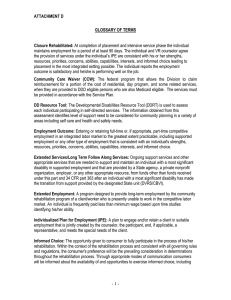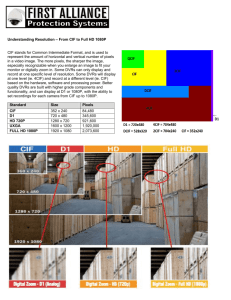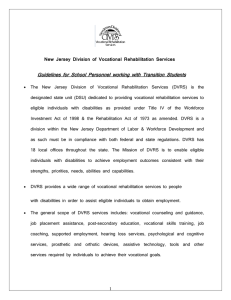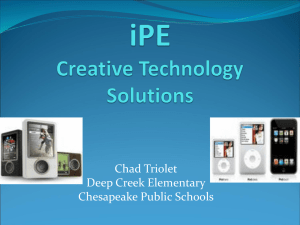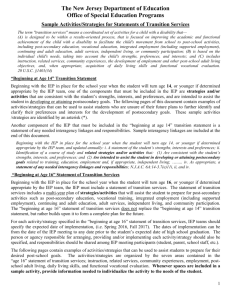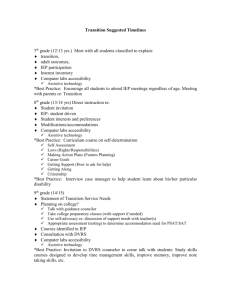Transition from School to Work Division of Vocational Rehabilitation services (DVRS)
advertisement
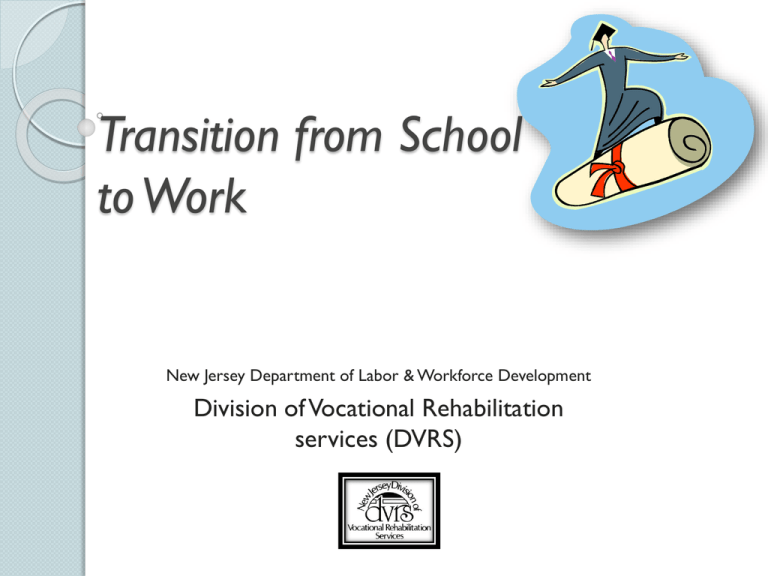
Transition from School to Work New Jersey Department of Labor & Workforce Development Division of Vocational Rehabilitation services (DVRS) Who is DVRS? The DVRS is the designated state agency administered through the federal government and the New Jersey Dept. of Labor & Workforce Development (LWD) that helps individuals with disabilities prepare for, obtain, and maintain gainful employment. 6/23/2016 2 Mission Statement It is the Mission of DVRS to “enable eligible individuals with disabilities to achieve an employment outcome consistent with their strengths, priorities, needs, and capabilities.” DVRS assists individuals prepare for, obtain, & maintain “competitive employment” Full or Part-time work performed in the community for which the individual is paid at least minimum wage. (For the complete definition see below.) Competitive employment means work—(i) in the competitive labor market that is performed on a full-time or part-time basis in an integrated setting; and (ii) for which an individual is compensated at or above the minimum wage, but not less than the customary wage and level of benefits paid by the employer for the same or similar work performed by individuals who are not disabled.” [34 CFR §361.5(b)(11)]. (Code of Federal Regulations) Integrated Setting – An employment setting typically found in the community in which the employee with a disability is working in the same setting as those without a disability. And…interacts to the same extent that non-disabled individuals in comparable positions interact with their fellow co-workers. ~CFR, 361.5(b)33 6/23/2016 4 Employment First New Jersey became the 14th state to adopt an Employment First initiative. Employment First is a concept to facilitate the full inclusion of people with the most significant disabilities in the workplace and community. Under the Employment First approach, community-based, integrated employment is the first option for employment services for youth and adults with significant disabilities. ~US Dept. of Labor (USDOL) USDOL’s Office of Disability Employment Policy (ODEP) has initiated a public service announcement to promote the employment of individuals with disabilities, called “What Can You Do?” http://www.whatcanyoudocampaign.org/ What does DVRS offer to transition students and schools? DVRS collaborates with school districts to provide consultation, eligibility determination and transition planning for youth with disabilities. How can DVRS be present at the schools? • • • Consultations: As soon as a student turns age 14, DVRS counselors can provide consultations to school staff, students and parents. Presentations: DVRS counselors can make presentations at secondary schools for staff, students, and parents when their schedule allows. IEP Meetings: For the most part, when the DVRS counselor attends IEP meetings it is for those students who are consumers of DVRS. DVRS counselors may attend meetings of other students if deemed appropriate, but only after having met with the student previously or at the very least having reviewed appropriate school documentation. Note: Such attendance is dependent on the counselor’s schedule. Some counselors may also be available via conference call if not able to come in person. Starting at age 14, the DVRS counselor can provide consultations related to the student’s disability and vocational rehabilitation needs. *Note: Student cannot be referred to DVRS for eligibility determination until such time that they are within 2 years of exiting the school system. Examples of consultations… Consulting with school, student, parent about the student’s disability related needs in relation to future employment, i.e. need of specific types of assistive technology, job coach, physical or mental therapies, among others. Providing information about disability related laws and policies. Making recommendations about the student’s vocational plan and opportunities for pre-vocational experiences. Recommending other state agencies, community based services, or local resources. Example: the local (CIL) Center for Independent Living. Who should be referred to DVRS? It is encouraged that students be referred to DVRS when… Student has expressed a desire to work in competitive employment. Student is within 2 years of exiting the school system. Student has a significant disability (physical, cognitive, and/or mental impairment) as documented in an IEP (Individualized Education Program), 504 Plan, and/or other evaluations or medical records. Student will require services from DVRS based on his or her disability related needs in order to be successfully employed. What are the Steps in the DVRS process? 1.THE REFERRAL Being referred to DVRS is the 1st step! School staff typically make the referral to DVRS. This fosters the collaboration between the school and DVRS and can streamline the process of obtaining school documentation related to the student’s disability. Students/Parents are encouraged to ask the school to make the referral to DVRS or may do so themselves if this has not happened well before the student’s exit from the school. *The Referral form is not an application. 10 6/2 3/2 016 What to Include in a Referral to DVRS… Copy of the student’s most recent psychological, social and learning assessments, Include a diagnosis (NJ Administrative Code 6A:14-3.5) and a current assessment of academic functioning. DOE’s “Vocational Profile” (as found on the DOE website) is an important tool to assist with planning as it documents strengths and limitations in functional terms and may note work interests and abilities gained through community work experience. An assessment of the student’s social skill levels and behavioral or safety issues should be included. Referral information continued… Reports from Structured Learning Experiences (SLE) or Community Based Instruction (CBI) job sampling sites Results from Interest testing Pertinent medical or psychiatric evaluations Student’s self-report of future career goals Copy of student’s Summary of Performance (SOP) developed in senior year. Next Step: 2.The Application Process After the referral to DVRS has been made, the student is assigned to a DVRS counselor for an Intake appointment. This is called a “Survey Interview.” Parents often accompany the student to this appointment. Please keep in mind the student is the consumer. At the Survey Interview, the DVRS counselor will review the student’s educational, medical, psychological & vocational assessments. 13 6/2 3/2 016 Application Process continued… The DVRS Counselor and student will discuss the student’s work history, related activities and vocational goals. There will also be a discussion of the student’s current disability related needs and how this may impact vocational planning. The DVRS Counselor will explain the DVRS process and services. DVRS is a voluntary service! If the student wants to pursue services with DVRS he or she will then officially apply for services at the Intake Interview. 14 6/2 3/2 016 Next step: 3. Determining Eligibility In order to be eligible for DVRS services, students must have a documented physical, cognitive, or mental/emotional impairment that poses a substantial barrier to employment, and Requires vocational rehabilitation services in order to prepare for, secure, maintain, or regain employment The Student’s school and medical records are reviewed as part of the eligibility determination. There is an assessment of the specific barriers or impediments to employment that the student may have as a result of his or her disability. 15 6/2 3/2 016 Eligibility Determination continued… DVRS evaluates impediments to employment based on Functional Limitations in areas such as: Communication Interpersonal Skills Mobility Self-Care Self-Direction Work Skills Work Tolerance Next Step: 4. Individualized Plan for Employment (IPE) An IPE may be developed after the consumer is determined eligible for DVRS services. The IPE is a written agreement between the student and the DVRS counselor. The IPE is developed when the student and DVRS counselor together have identified a vocational goal and have determined the specific services that will be needed by the student to achieve such goal. 17 6/2 3/2 016 IPE Continued… Provision of services is individualized based on the person’s work history, skill level, disability related limitations as well as client choice, interests, abilities and strengths. Vocational Counseling and Guidance is the core service provided on every IPE starting at the time that the IPE is initiated. All services on an IPE must be related to the vocational goal and serve the intended purpose of successful employment. Generally speaking, services other than vocational counseling & guidance will be provided after the student has exited the school system. Vocational Counseling and Guidance provided to the student could include: Career Assessments Resume and cover letter preparation Mock interviews to practice interviewing skills Tips on “Dressing for Success.” Job search strategies, including use of current technology Self-advocacy skills Educating student as to the skills needed for work readiness Information on “In-Demand” occupations. 19 6/2 3/2 01 6 Upon exiting school, other services that may provided to DVRS Consumers… Diagnostic Evaluations: i.e. Medical, Mental health, Assistive Technology, Pre-Vocational, Driver Evaluations, etc. Time-limited Job Coaching Supported Employment (intensive job coaching) Assistive technology, Auxiliary Aids Funding for school or training programs Referral and time limited funding for specific type of therapies, and much more… Many services are of no cost to the individual including job coaching and vocational counseling & guidance. Other services may be based on a financial needs assessment. Last Step in the DVRS Process: 5. Case Closure The DVRS consumer’s case is closed when the individual has been successfully employed for a minimum of 90 days. In addition, this typically means that the specific services provided through DVRS have ended. Consumers may reapply to DVRS if their job situation changes. Where does the student meet with the DVRS counselor? DVRS has 18 local offices located throughout the state. Typically individuals choose to go to the local office that is closest to where they live. There are times when a student may have an initial meeting with their DVRS counselor at their school, but most meetings will happen at the DVRS office. The administrative offices for DVRS are at the NJ Dept. of Labor building in Trenton, NJ Contact information for all offices can be found in the last few slides of this presentation. How the student’s family can play a role in transition planning… Promote independence, self-sufficiency, self –advocacy through use of volunteer opportunities, part-time jobs, household chores, etc. Assist student in continuing to understand his or her strengths and areas for development in relation to employment. Assist student with transportation issues, i.e. use of public transportation, applying for Access Link through NJ Transit. If student receives SSI benefits, he or she may still work without losing benefits! Find out more information on how employment may impact benefits and medical insurance. Consult with the student’s Child Study Team, and other school personnel about any and all opportunities for work experiences! Learn ways that the student can develop “soft skills”… 6/23/2016 23 Why “Soft Skills” are so important! In today’s job market, more than ever, employers want their employees to have “soft skills” or what is sometimes referred to as “people skills.” Soft skills may include: good manners, communication skills, a sense of humor, motivation, responsible behavior, etc. It is important that students, families and schools to find ways for students to develop and practice such skills both at school and at home. The U.S. Dept. of Labor has developed a curriculum entitled “Soft Skills to Pay the Bills” (See the slide on resources for the website). 6/23/2016 24 Why work with DVRS? DVRS counselors are trained experts in vocational planning, job development and job placement. They are equipped to assess what services the consumer may need in order to ensure successful employment. DVRS counselors have access to the latest labor market information and what employers want in an employee. Tips for Transition Coordinators and designated school staff… Refer to the document “Guidelines for School Personnel working with Transition Students” to review procedures and practices when referring students to DVRS. (Document can be found on both the LWD and OSEP website.) Prepare your students for their initial interview with DVRS by reviewing with them the “Steps in the DVRS Process” as found in the OSEP Transition Tool Box and on the DVRS website. Consult with the DVRS counselor assigned to your school as much as possible. Send thorough and updated information to DVRS when referring students. Refer appropriate students to DVRS as soon as you can within 2 years of student exiting the school system. Resources NJ LWD /NJDVRS- www.lwd.state.nj.us/labor/ (Click on “vocational rehabilitation” to access DVRS’s information.) US Dept. of Labor-Office of Disability Employment Policy (ODEP)www.dol.gov/odep ODEP’s “Soft Skills to Pay the Bills” Curriculum (PDF format),www.dol.gov/odep/topics/youth/softskills Job Accommodation Network (JAN)- www.askjan.org NJ Statewide Independent Living Council –www.njsilc.org/ (Provides information about the Centers for Independent Living) NCWD/Youth is a source for information about employment and youth with disabilities. -www.ncwd-youth.info www.mynextmove.org- career planning website geared toward youth. Pacer (organization based in Minnesota providing information and resources regarding children with disabilities) www.pacer.org 6/23/2016 27 How to Contact DVRS There are eighteen offices located throughout New Jersey. To learn more about how DVRS can help, or if you have questions about the information presented today, contact the office nearest you as listed in the next slide. DVRS also has an administrative office located in Trenton, NJ. This office can be reached at: (609) 292-5987, (609) 292-2919, (TTY) Website: http://lwd.state.nj.us DVRS Local Offices Bridgeton (Cumberland, Salem) 856-453-3888 New Brunswick (Middlesex) 732-937-6300 Camden (Camden) 856-614-2500 Paterson (Passaic) 973-742-9226 Elizabeth (Union) 908-965-3940 Pleasantville (Atlantic) 609-813-3933 Hackensack (Bergen) 201-9968970 Somerville (Somerset, Hunterdon) 908-704-3030 Hackettstown (Sussex, Warren) 908-852-4110 Thorofare (Gloucester) 856-384-3730 Toms River (Ocean) 732-505-2310 Trenton (Mercer) 609-292-2940 Westampton (Burlington)609-518-3948 Wildwood (Cape May) 609-523-0330 Jersey City (Hudson) 201-217-7180 Morristown (Morris) 973-631-6304 Neptune (Monmouth) 732-7751799 Newark (Essex) 973-648-3494 6/23/2016 29 Questions ???
